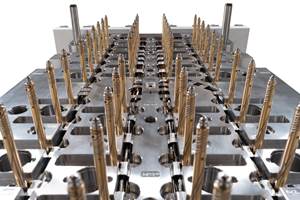Prototyping Checklist: How to Choose
Today there are many prototyping technologies to support the full development cycle of a product from initial idea to manufacturing full-scale parts to low-volume production.
Today there are many prototyping technologies to support the full development cycle of a product from initial idea to manufacturing full-scale parts to low-volume production. Read this brief overview about the advantages and disadvantages for two of the most popular additive technologies used for prototyping and production. With complementary strengths and weaknesses, one of these two technologies can handle almost any application.
Rapid prototyping is defined as creating a prototype using an additive fabrication process, which builds the part up in layers. This is as opposed to subtractive fabrication processes—such as milling and machining—which start with a block of material and cut away from it to create a part. All rapid prototyping technologies work by replicating cross-sectional layers from CAD data. Depending on the technology these layers are either extruded, jetted, cured (laser or UV light), laminated or sintered. All are created layer by layer to build up or grow the part. All technologies can produce complex, intricate geometries, which, in many cases, could not be created with a subtractive process. The smaller, less expensive additive fabrication systems are often referred to as 3-D printers.
1. Fused Deposition Modeling (FDM)
FDM liquefies solid thermoplastic and extrudes it through nozzles not much thicker than a human hair. Each layer of plastic fuses to the previous one and is immediately solidified.
FDM first became widely used because of its ability to model with engineering thermoplastics that create tough, durable parts for functional testing. However, the process has become known for its accuracy, which today rivals injection molding tolerances. FDM produces accuracies as high as 0.003 in. The trade-off with FDM is that it cannot create a surface finish with the crisp appearance and sharp glass-like edges like a photopolymer prototyping system can. However surface finishes can be smoothed, if needed, in a separate, optional smoothing process. The FDM process offers nine varieties of engineering thermoplastics. It should be noted that a smooth surface finish or sharp edge is not an indicator of accuracy. Accuracy is the ability to hold to a given tolerance, which FDM excels at.
2. Photopolymer Jetting (PolyJet)
Photopolymer jetting (or PolyJet) builds prototypes by jetting liquid photopolymer resin from ink-jet style heads. The resin is sprayed from the moving heads, and only the amount of material needed is used. UV light is simultaneously emitted from the head, which cures each layer of resin immediately after it is applied. The process produces excellent surface finish and feature detail. Photopolymer jetting is used primarily to check form and fit, and can handle limited functional tests due to the limited strength of photopolymer resins.
This process offers the unique ability to create prototypes with more than one type of material. For instance a toothbrush prototype could be composed with a rigid shaft with a rubber-like over-molding for grip. The process works with a variety of proprietary photopolymer resins as opposed to production materials. A tradeoff with this technology is that exposure to ambient heat, humidity or sunlight can cause dimensional change that can affect tolerance. The process is faster and cleaner than the traditional vat and laser photo-polymer processes.
Related Content
The Role of Social Media in Manufacturing
Charles Daniels CFO of Wepco Plastics shares insights on the role of social media in manufacturing, how to improve the “business” side of a small mold shop and continually developing culture.
Read MoreLeading Mold Manufacturers Share Best Practices for Improving Efficiency
Precise Tooling Solutions, X-Cell Tool and Mold, M&M Tool and Mold, Ameritech Die & Mold, and Cavalier Tool & Manufacturing, sit down for a fast-paced Q&A focused on strategies for improving efficiencies across their operations.
Read MoreHow to Solve Hot Runner Challenges When Molding with Bioresins
A review of the considerations and adaptations required to design hot runners and implement highly productive injection molding operations.
Read MoreMMT Chats: 5 in 5 with Best Tool and Engineering
MoldMaking Technology Editorial Director Christina Fuges reveals 5 best practices for improving efficiencies within shops...in 5 minutes. Our guest is Joe Cherluck, President of Best Tool and Engineering in Clinton Township, Michigan.
Read MoreRead Next
Are You a Moldmaker Considering 3D Printing? Consider the 3D Printing Workshop at NPE2024
Presentations will cover 3D printing for mold tooling, material innovation, product development, bridge production and full-scale, high-volume additive manufacturing.
Read MoreHow to Use Strategic Planning Tools, Data to Manage the Human Side of Business
Q&A with Marion Wells, MMT EAB member and founder of Human Asset Management.
Read MoreReasons to Use Fiber Lasers for Mold Cleaning
Fiber lasers offer a simplicity, speed, control and portability, minimizing mold cleaning risks.
Read More












.jpg;maxWidth=300;quality=90)








